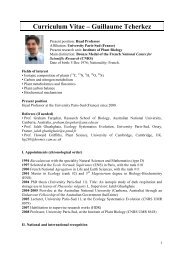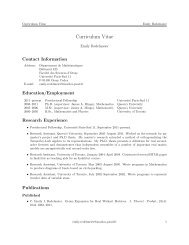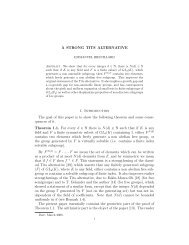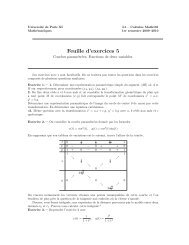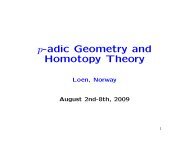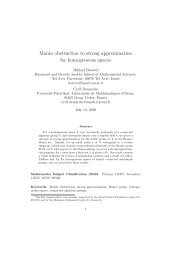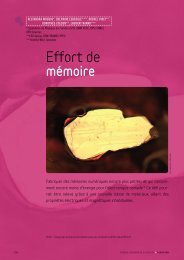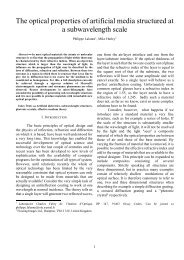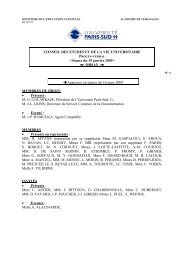Birational invariants, purity and the Gersten conjecture Lectures at ...
Birational invariants, purity and the Gersten conjecture Lectures at ...
Birational invariants, purity and the Gersten conjecture Lectures at ...
You also want an ePaper? Increase the reach of your titles
YUMPU automatically turns print PDFs into web optimized ePapers that Google loves.
36<br />
of <strong>the</strong> integral cohomology group H 2 (G, Q/Z) ≃ H 3 (G, Z) consisting of classes whose<br />
restrictions to all abelian subgroups of G vanish. This condition is equivalent to <strong>the</strong><br />
vanishing of restrictions to all abelian subgroups with <strong>at</strong> most two gener<strong>at</strong>ors.<br />
Bogomolov’s formula in turn is subsumed in Saltman’s formula [Sa90] for <strong>the</strong> unramified<br />
Brauer group of twisted multiplic<strong>at</strong>ive field <strong>invariants</strong>.<br />
Let G be a connected, reductive group over an algebraically closed field k of characteristic<br />
zero. Let G ⊂ GL n be an injective homomorphism. One may <strong>the</strong>n consider <strong>the</strong><br />
quotient variety X = GL n /G, which is an affine variety since G is reductive. It is an<br />
open question whe<strong>the</strong>r <strong>the</strong> (obviously unir<strong>at</strong>ional) variety X is a r<strong>at</strong>ional variety. Saltman<br />
([Sa85], [Sa88]) <strong>and</strong> Bogomolov [Bo89] have studied this problem. For G = P GL r ,<br />
Saltman [Sa85] (see [CT/Sa87] for a different proof) <strong>and</strong> Bogomolov for G arbitrary<br />
([Bo89], see also [CT/Sa88]) showed th<strong>at</strong> <strong>the</strong> unramified Brauer group of k(GL n /G) is<br />
always zero.<br />
Taking <strong>the</strong> point of view of unramified cohomology, one may h<strong>and</strong>le <strong>the</strong> Artin-<br />
Mumford example quoted above, as well as o<strong>the</strong>r examples, in a manner totally parallel<br />
to th<strong>at</strong> of § 1. Indeed, in § 1, <strong>the</strong> function field L = C(X) is a quadr<strong>at</strong>ic field extension<br />
of <strong>the</strong> r<strong>at</strong>ional function field in one variable K = C(t), th<strong>at</strong> is it is <strong>the</strong> function field<br />
of a 0-dimensional conic over C(t). A key point in <strong>the</strong> proof we gave in § 1 is <strong>the</strong> exact<br />
sequence<br />
1 → Z/2 → K ∗ /K ∗2 → L ∗ /L ∗2<br />
th<strong>at</strong> is<br />
1 → Z/2 → H 1 (K, Z/2) → H 1 (L, Z/2)<br />
associ<strong>at</strong>ed to <strong>the</strong> quadr<strong>at</strong>ic field extension L/K., which gives control on <strong>the</strong> kernel of<br />
<strong>the</strong> map K ∗ /K ∗2 → L ∗ /L ∗2 . Let α ∈ H 1 (K, Z/2) be <strong>the</strong> gener<strong>at</strong>or of <strong>the</strong> above kernel.<br />
Note th<strong>at</strong> α is a ramified element in K ∗ /K ∗2 . Nontrivial unramified elements in L ∗ /L ∗2<br />
are <strong>the</strong>n produced in <strong>the</strong> following way. Let β ≠ 1, α be a ramified element in K ∗ /K ∗2 .<br />
Suppose th<strong>at</strong> all ramific<strong>at</strong>ion of β is “contained” in <strong>the</strong> ramific<strong>at</strong>ion of α. Since α dies in<br />
L ∗ /L ∗2 , so does its ramific<strong>at</strong>ion, hence so does <strong>the</strong> ramific<strong>at</strong>ion of β when going over to<br />
L. However, because β does not lie in <strong>the</strong> <strong>the</strong> kernel of K ∗ /K ∗2 → L ∗ /L ∗2 , β itself does<br />
not die when going up to L : this produces a nontrivial unramified element in L ∗ /L ∗2 .<br />
Now let L be <strong>the</strong> function field of a 1-dimensional conic over <strong>the</strong> r<strong>at</strong>ional function<br />
field in two variables K = C(t 1 , t 2 ). If L is <strong>the</strong> function field of a smooth projective<br />
conic over a field K, it is a special case, already known to Witt ([Wi35] p.465), of a<br />
result of Amitsur th<strong>at</strong> <strong>the</strong> kernel of <strong>the</strong> map H 2 (K, Z/2) → H 2 (L, Z/2) is ei<strong>the</strong>r 0 or<br />
Z/2, depending on whe<strong>the</strong>r <strong>the</strong> conic has a K-r<strong>at</strong>ional point or not. In <strong>the</strong> second case,<br />
<strong>the</strong> nontrivial element in H 2 (K, Z/2) ≃ 2 Br(K) is <strong>the</strong> class of <strong>the</strong> qu<strong>at</strong>ernion algebra<br />
α associ<strong>at</strong>ed to <strong>the</strong> conic. Now this is an exact analogue of <strong>the</strong> situ<strong>at</strong>ion above. To<br />
produce an unramified element in H 2 (L, Z/2) one should <strong>the</strong>refore look for an element<br />
β ∈ H 2 (K, Z/2) which is nei<strong>the</strong>r 0 nor α, but whose ramific<strong>at</strong>ion (as an element of<br />
H 2 (K, Z/2)) is “somehow” domin<strong>at</strong>ed by <strong>the</strong> ramific<strong>at</strong>ion of α, so th<strong>at</strong> when going over<br />
to L, all ramific<strong>at</strong>ion of β L ∈ H 2 (L, Z/2) vanishes – although β itself does not vanish.



